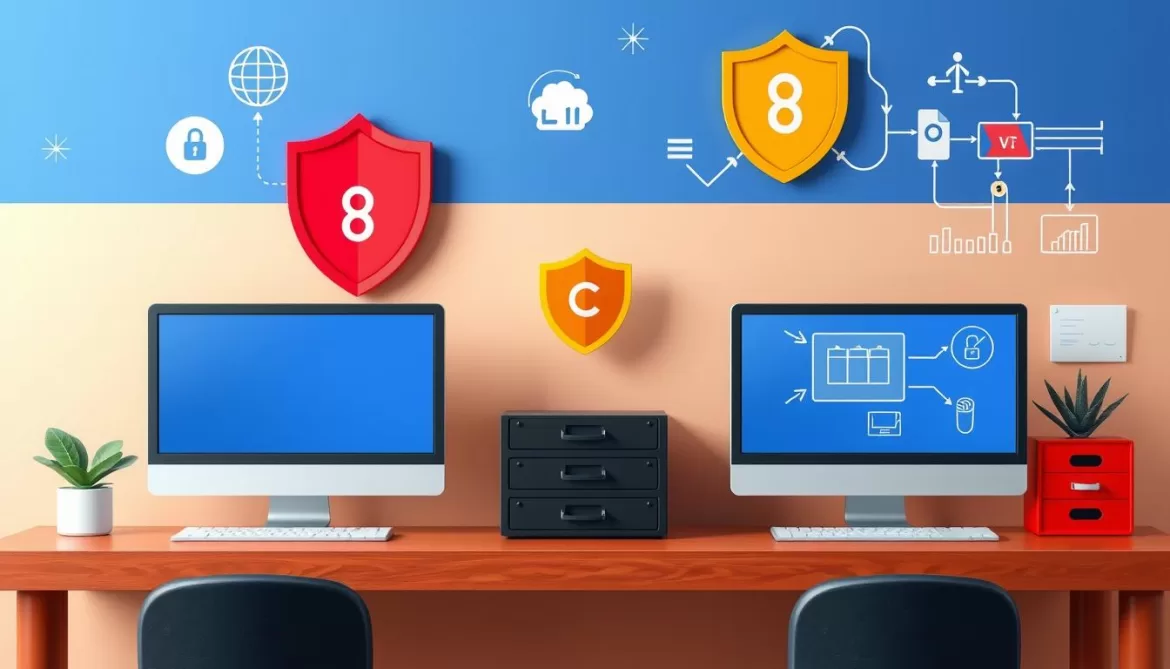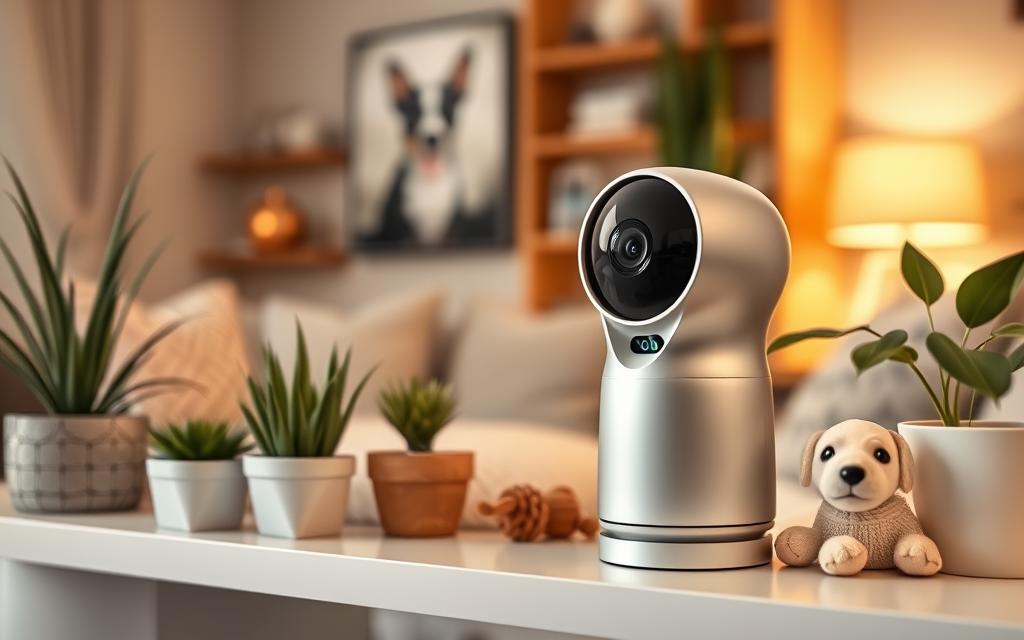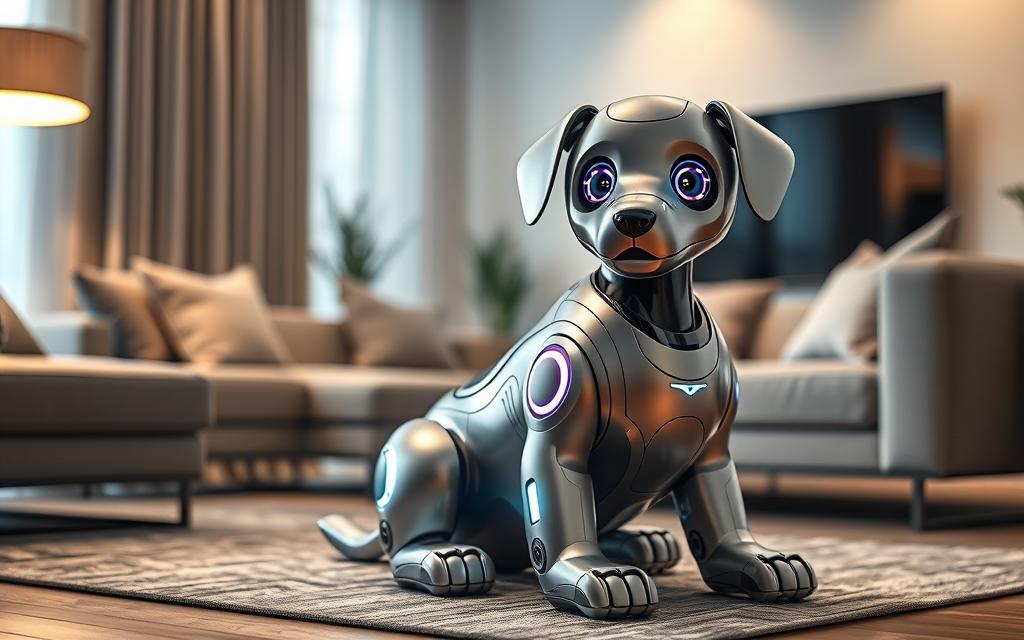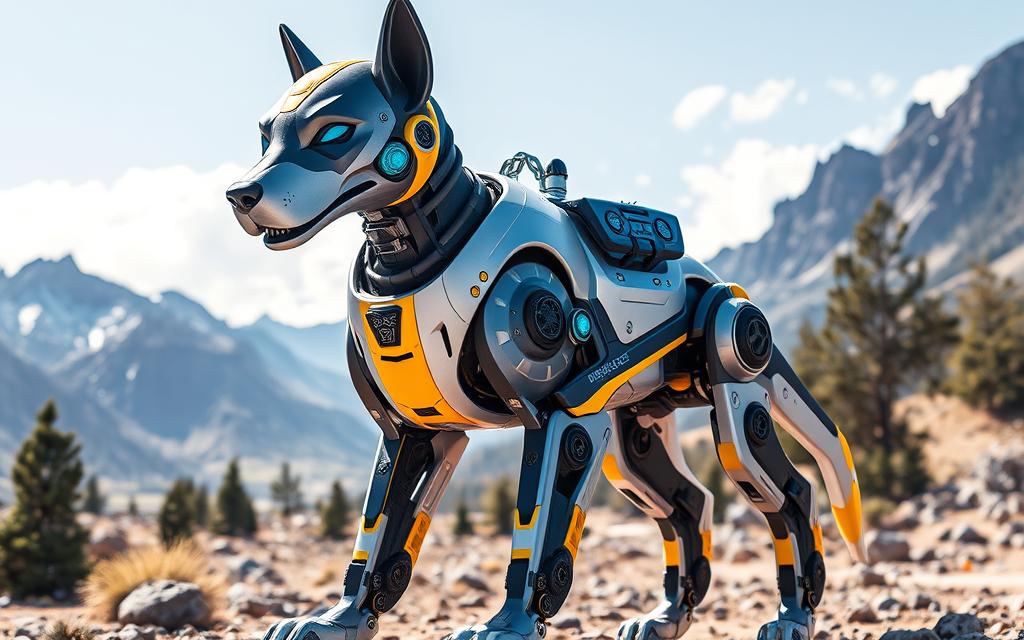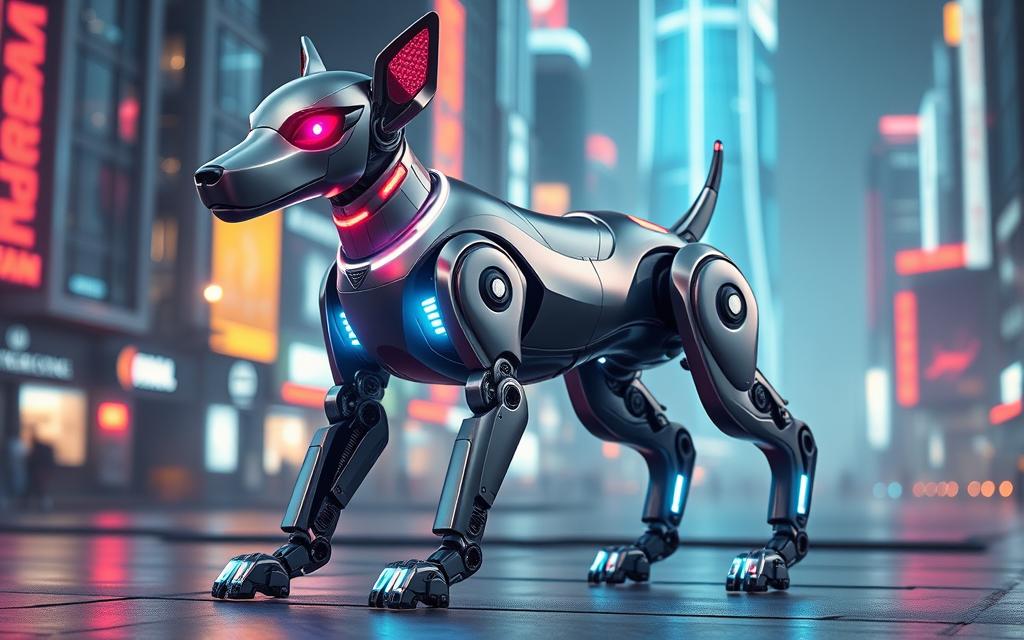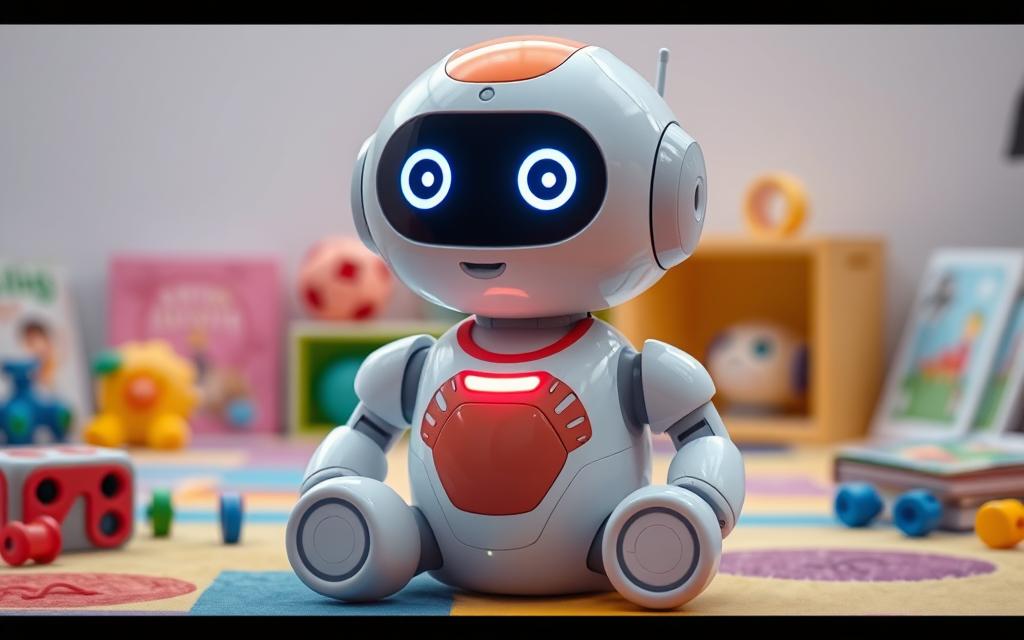I’ve always been amazed by dancers’ grace and skill. They can express emotions and tell stories through movement. Now, imagine dance performed by robots.
Technology is changing our world fast. Robotics and the performing arts are merging. Companies like Boston Dynamics are leading this change. Their robots, like Spot and Atlas, can run, jump, and even dance.
These robots have become YouTube stars. They have millions of views and likes. People love their smooth, lifelike movements.
The Boston Dynamics AI Institute has just started. Hyundai is supporting it. Marc Raibert, the founder, wants robots to be more than just machines. He wants them to connect with us on a deeper level.
Key Takeaways
- Boston Dynamics, a leader in developing legged robots, has been acquired by Hyundai and is expanding its focus on advanced AI capabilities.
- Robots like Spot and Atlas have garnered significant online attention, demonstrating the growing public interest in dancing robots.
- Researchers are exploring the integration of physical form and AI to push the boundaries of robotic capabilities, including in the realm of dance and performance.
- The Boston Dynamics AI Institute is working on a range of projects, from bicycle repairs to dexterous manipulation, to advance robot intelligence.
- Experts believe that the future of robotics lies in developing cognitive abilities beyond just physical movement, to create more engaging and lifelike performances.
Introduction to Dancing Robots
In the world of entertainment, a new art form is rising – robotic choreography. Technology is pushing what’s possible, bringing android dancers and AI dance performances to life. This section explores the world of synthetic dance troupes and the mix of tech and performance.
Robotic Choreography: A New Art Form
Robotic choreography combines engineering and dance, blending programmable dance movements with precision. This team effort creates stunning routines that change how we see non-human performers.
The Nezha Inventor’s Kit V2 is used in educational courses. It teaches students about motor control, gearing, and balance. Students build their own dancing robots, learning creativity, problem-solving, and teamwork.
The Intersection of Technology and Performance
Technology and performance are merging, changing entertainment. AI dance performances and synthetic dance troupes mix human art with robotic precision. They use programming, sensors, and algorithms to push performance limits.
In choreorobotics, roboticists use dance principles for their creations. This mix creates unique, emotionally powerful shows. The audience is amazed by the technological wonders.
The Mechanics Behind Dancing Robots
Dancing robots amaze us with their complex mechanisms and smart programming. These marvels come from years of research and innovation. They show what’s possible in robotic design and dance.
Synchronized Programming and Precise Movements
Robotic engineers have worked hard to make these robots dance perfectly. They use advanced algorithms and control systems. This lets the robots move in perfect sync, like a mechatronic ballet.
Getting this precision is tough. The robots need to move exactly right, with every part working together. They use special sensors, fast processors, and detailed software. This turns them into amazing machine-driven choreographies.
“The skills learned in teaching robots to dance, do gymnastics, or parkour are believed to be fundamental to a wide variety of robot applications, emphasizing the transferability of agility, balance, and perception in robotics.”
Creating these robots has also helped improve motion control, balance, and perception. As synchronized programming and precise movements get better, we can expect even more amazing robot dances.
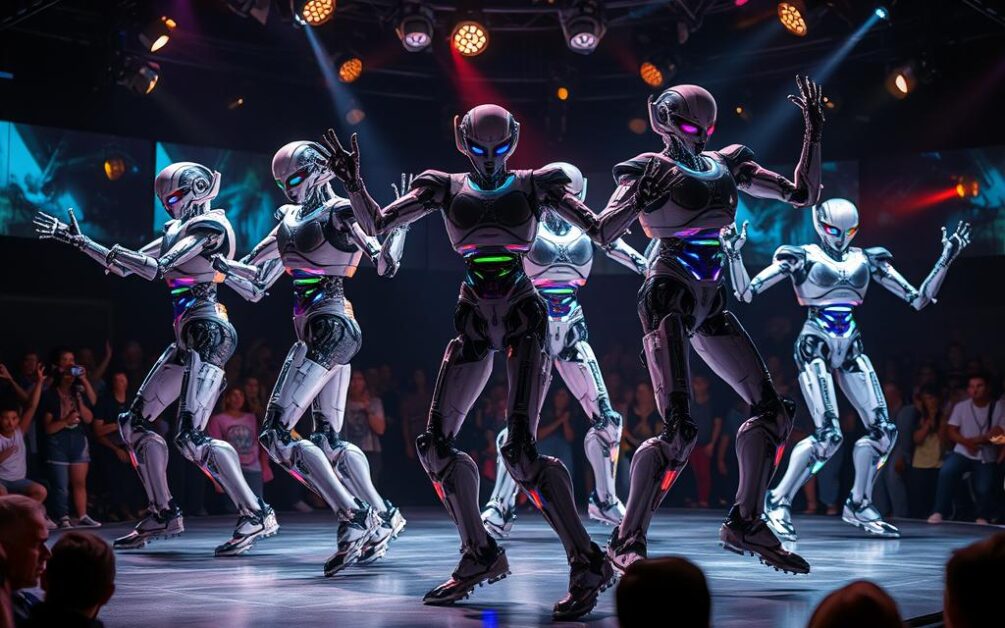
Dancing Robots: Pushing the Boundaries of Robotic Design
Robots have made a big splash in the dance world, changing how we think about design and what robots can do. Back in the 1980s, Margo Apostolos started “choreorobotics” at the University of Southern California. This was a big step into combining dance and robotics.
Today, dancers, choreographers, and engineers work together more than ever. A key moment was when Sydney Skybetter and Catie Cuan teamed up with engineers. This marked a big leap forward in the art of dancing robots.
Even though technology is changing dance, robots and virtual reality are still not as common. But Kate Ladenheim is using robots to challenge old ideas about gender in robotics. This shows how dance and technology are changing together.
Technology is making dance performances better, like Beyoncé’s The Renaissance World Tour with robot arms. Stanford University also made an AI called EDGE. It creates dance animations that match music perfectly.
“The advanced Atlas robot utilized 28 actuators, a gyroscope for balance, and three quad-core onboard computers to execute the dance moves.”
People are working hard to make robot dancers more expressive. They’re using new materials and ways to control robots. This is opening up new possibilities in the entertainment world. A video of robots dancing to “Do You Love Me?” by The Contours shows how far we’ve come.
The world of choreorobotics is always growing, and so are the feelings between humans and robots in dance. Some dancers worry robots can’t replace human touch. But others, like Skybetter, see robots as a way to explore new dance ideas.
Choreographing for Non-Human Dancers
The world of robotics is growing fast, making it exciting to choreograph dances for robots. Choreographers and engineers are working together. They aim to create amazing routines that show off what robots can do.
Challenges and Creative Approaches
Creating dances for robots is different from working with humans. Robots have their own limits and can’t improvise. Choreographers must plan every step carefully, considering the robots’ movements and how to make them dance together.
This challenge also opens up new creative possibilities. Choreographers are finding fresh ways to express movement and rhythm. They use the robots’ special qualities to create stunning performances.
Catie Cuan, a PhD candidate at Stanford University, is leading this new field. She focuses on making robot movements less scary and more like humans. She believes that how robots move is key to better human-robot interaction.
“Working with robots provided a new and interesting experience, pushing the boundaries of movement possibilities beyond human bodies.”
As robotic dance grows, choreographers and engineers are working together. They face challenges but also find new ways to be creative. From Sydney Skybetter’s Choreorobotics course at Brown University to the famous Boston Dynamics video, their work is changing entertainment and art.
The Evolution of Robotic Dance Performances
Dance has seen a big change with robotic performances. It started in the 1970s with Michael Jackson‘s “Dancing Machine” routine. Now, we see new steps in robotic choreography.
Roboting, a dance that looks like robots moving, is getting more popular. In 2009, 318 people danced together in Australia, setting a record. This dance style is now loved by many.
Today, choreographers use robots and AI in their shows. This makes the dance more interactive. Groups like Jabbawockeez, Kinjaz, Poppin’ John, and Marquese Scott are leading this trend. They mix different dances with robot-like moves.
The future of robotic dance looks bright. New tech like VR and AR could change how we watch dance. These technologies could make dance shows more real and fun.
| Year | Milestone |
|---|---|
| 1970s | The robot dance style gained fame after Michael Jackson used it in his performance of “Dancing Machine”. |
| 2009 | Robogals at the University of Melbourne, Australia, broke the Guinness World Record for the Largest Robot Dance with 318 participants. |
| 2019 | The ballet Coppélia was remade by choreographer Chase Brock as The Girl with the Alkaline Eyes, incorporating themes from TV show Black Mirror and the science fiction film Ex Machina. |
As robotic dance keeps growing, we’ll see more amazing shows. These shows will mix technology and dance in new ways.
Potential Applications and Future Prospects
Dancing robots are changing the game in entertainment. They can make live events better and create new experiences. These robots are set to revolutionize how we enjoy shows.
Enhancing Live Events
Dancing robots can make concerts and stage shows even more exciting. They perform amazing, synchronized dances that wow the crowd. This adds a special touch to any event.
These robots could soon be the stars of the show. As they get better, they’ll move like humans, making the line between real and fake disappear.
Immersive Experiences with Robots
Dancing robots can also change how we enjoy entertainment. They can be part of interactive installations or virtual worlds. This creates a mix of the real and digital that’s hard to beat.
Imagine walking through an art show with robots that respond to you. Or seeing a virtual reality show with holographic dancers. These ideas are just the start of what’s possible.
The future of dancing robots is bright. With new tech, the entertainment world will keep getting more exciting. The possibilities are endless.
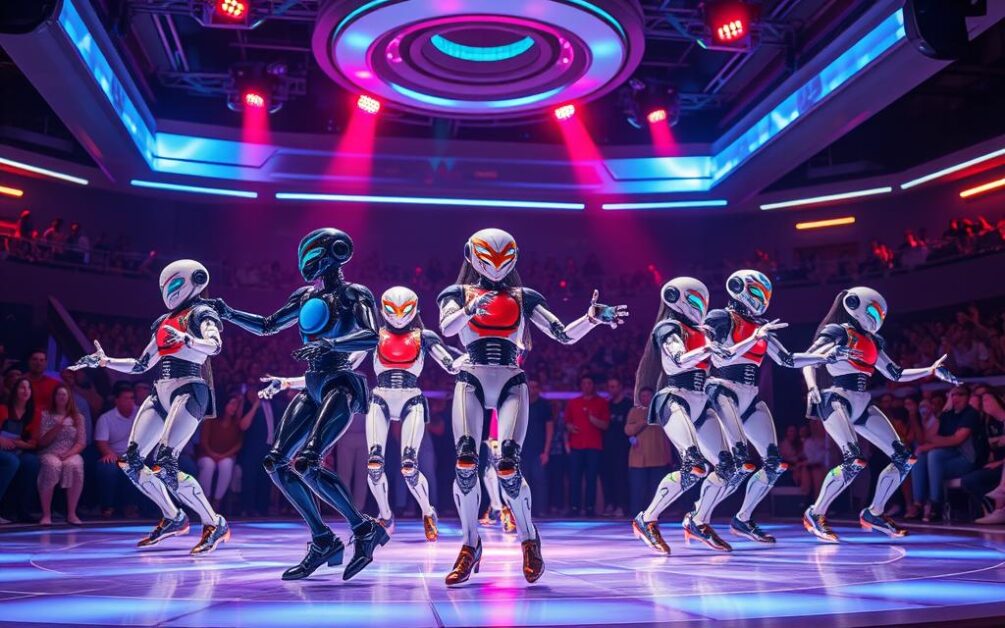
Conclusion
Dancing robots are changing the game in performance art, winning hearts worldwide. Their precise movements bring a new level of entertainment. This mix of technology and art creates unforgettable shows.
The future of robotic dance looks bright, with new tech advancements on the horizon. These will make live shows even better and bring audiences closer to the action. Robotic dance is also helping in autism therapy, improving social skills and communication.
Innovation in robotic dance is just starting, with more amazing shows to come. The blend of tech and art shows our endless creativity. This marks the start of a thrilling new era for dancing robots, exciting audiences everywhere.
